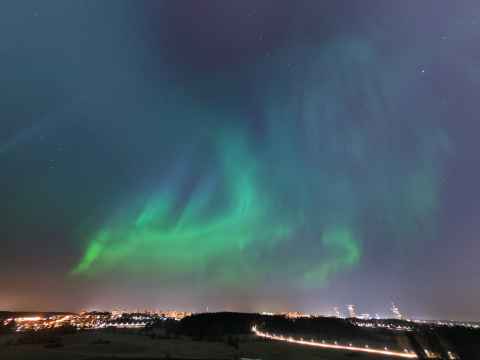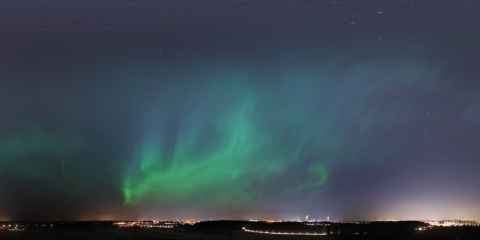Northern Lights
Due to the biggest solar flare that has come to earth in the last 19 to 20 years
[*][a][1] we were treated to northern lights in Stockholm. Here seen from Granholmstoppen over Husby, Kista and Akalla.
Of course, while the northern lights are seen "over" Husby, Kista and Akalla, the light-emitting molecules are much higher up and far away. The base of the aurora is at approximately 8 degrees from the horizon, and green auroras have their base at about 100 km above ground.
Given that, we can draw a triangle with one vertex in the center of the earth, one where we stand, and one where the base of the aurora is.
We can also plug in two sides and one angle, which is enough to fix the remaining side and the other two angles, (using the excellent Triangle Calculator[b]).
The Earth's polar circumference is 40,008 km, so a 4.8 degree angle at the center translates to (4.8/360) * 40008 ~~ 530 km along the surface. The bright spot at the aurora's left is at about 14.5 degrees east. If we move 530 km in that direction we end up at 64.010587N 20.630992E, or in the middle of the lake Risträsket, Sweden[c]. The "hook" at the aurora's right is at 94.2649 degrees east and 15 degrees above the horizon. Doing the same calculations we get a distance of 330 km, which puts us at 59.060449N, 23.644372E, or in a farm field in Väike-Nõmmküla, Estonia[d]. Finally, the "tip" right in the center of the aurora is 36 degrees above the horizon and at 60 degrees east - which gives us a distance of about 130 km and places us at 59.977986N, 19.971739E: Nyhamnsfjärden, Åland[e]
Plotting that on a map, we get something like this:
Now, I suspect I'm off by at least 100 kilometers - but as an approximation it's OK.

